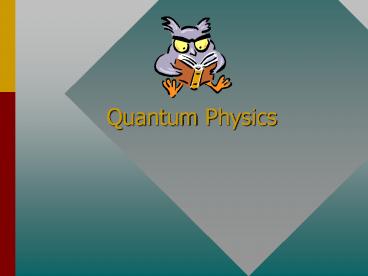Quantum Physics - PowerPoint PPT Presentation
Title:
Quantum Physics
Description:
Objectives: After completing this module, you should be able to: Discuss the meaning of quantum physics and Planck s constant for the description of matter in terms ... – PowerPoint PPT presentation
Number of Views:315
Avg rating:3.0/5.0
Title: Quantum Physics
1
Quantum Physics
2
Objectives After completing this module, you
should be able to
- Discuss the meaning of quantum physics and
Plancks constant for the description of matter
in terms of waves or particles.
- Demonstrate your understanding of the
photoelectric effect, the stopping potential, and
the deBroglie wavelength.
- Explain and solve problems similar to those
presented in this unit.
3
Planks Constant
In his studies of black-body radiation, Maxwell
Planck discovered that electromagnetic energy is
emitted or absorbed in discrete quantities.
Apparently, light consists of tiny bundles of
energy called photons, each having a well-defined
quantum of energy.
4
Energy in Electron-volts
Photon energies are so small that the energy is
better expressed in terms of the electron-volt.
One electron-volt (eV) is the energy of an
electron when accelerated through a potential
difference of one volt.
5
Example 1 What is the energy of a photon of
yellow-green light (l 555 nm)?
First we find f from wave equation c fl
E 3.58 x 10-19 J
6
Useful Energy Conversion
Since light is often described by its wavelength
in nanometers (nm) and its energy E is given in
eV, a conversion formula is useful. (1 nm 1 x
10-9 m)
If l is in nm, the energy in eV is found from
Verify the answer in Example 1 . . .
7
The Photo-Electric Effect
When light shines on the cathode C of a
photocell, electrons are ejected from A and
attracted by the positive potential due to
battery.
There is a certain threshold energy, called the
work function W, that must be overcome before any
electrons can be emitted.
8
Photo-Electric Equation
The conservation of energy demands that the
energy of the incoming light hc/l be equal to the
work function W of the surface plus the kinetic
energy ½mv2 of the emitted electrons.
9
Example 2 The threshold wavelength of light for
a given surface is 600 nm. What is the kinetic
energy of emitted electrons if light of
wavelength 450 nm shines on the metal?
K 2.76 eV 2.07 eV
K 0.690 eV
10
Stopping Potential
A potentiometer is used to vary to the voltage V
between the electrodes.
Kmax eVo
11
Slope of a Straight Line (Review)
The general equation for a straight line is
y mx b
The x-intercept xo occurs when line crosses x
axis or when y 0.
The slope of the line is the rise over the run
12
Finding Plancks Constant, h
Using the apparatus on the previous slide, we
determine the stopping potential for a number of
incident light frequencies, then plot a graph.
Note that the x-intercept fo is the threshold
frequency.
13
Example 3 In an experiment to determine Plancks
constant, a plot of stopping potential versus
frequency is made. The slope of the curve is 4.13
x 10-15 V/Hz. What is Plancks constant?
h e(slope) (1.6 x 10-19C)(4.13 x 10-15 V/Hz)
Experimental Plancks h 6.61 x 10-34 J/Hz
14
Example 4 The threshold frequency for a given
surface is 1.09 x 1015 Hz. What is the stopping
potential for incident light whose photon energy
is 8.48 x 10-19 J?
Photoelectric Equation
W (6.63 x 10-34 Js)(1.09 x 1015 Hz) 7.20 x
10-19 J
15
Total Relativistic Energy
Recall that the formula for the relativistic
total energy was given by
For a particle with zero momentum p 0
E moc2
A light photon has mo 0, but it does have
momentum p
E pc
16
Waves and Particles
We know that light behaves as both a wave and a
particle. The rest mass of a photon is zero, and
its wavelength can be found from momentum.
All objects, not just EM waves, have wavelengths
which can be found from their momentum
17
Finding Momentum from K.E.
In working with particles of momentum p mv, it
is often necessary to find the momentum from the
given kinetic energy K. Recall the formulas
K ½mv2 p mv
Multiply first Equation by m
mK ½m2v2 ½p2
18
Example 5 What is the de Broglie wavelength of a
90-eV electron? (me 9.1 x 10-31 kg.)
Next, we find momentum from the kinetic energy
p 5.12 x 10-24 kg m/s
l 0.122 nm
19
Summary
Apparently, light consists of tiny bundles of
energy called photons, each having a well-defined
quantum of energy.
20
Summary (Cont.)
If l is in nm, the energy in eV is found from
Wavelength in nm Energy in eV
21
Summary (Cont.)
Plancks Experiment
Incident light
Cathode
Anode
A
V
-
Potentiometer
Kmax eVo
22
Summary (Cont.)
Quantum physics works for waves or particles
For a particle with zero momentum p 0
E moc2
A light photon has mo 0, but it does have
momentum p
E pc
23
CONCLUSION Chapter 38BQuantum Physics



















![L 35 Modern Physics [1] PowerPoint PPT Presentation](https://s3.amazonaws.com/images.powershow.com/7552279.th0.jpg?_=20160119094)

![L 34 Modern Physics [1] PowerPoint PPT Presentation](https://s3.amazonaws.com/images.powershow.com/7125701.th0.jpg?_=20150905079)






![L 33 Modern Physics [1] PowerPoint PPT Presentation](https://s3.amazonaws.com/images.powershow.com/7602675.th0.jpg?_=201602121011)


